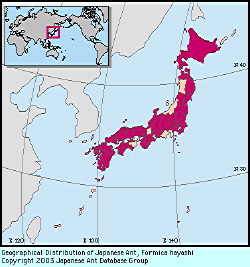
|
species
|
Formica hayashi
|
 |
Japanese Name
|
Hayashi-kuroyama-ari
|
Original Reference
|
|
Terayama, M. & Y. Hashimoto (1996) Taxonomic studies of the Japanese Formicidae, part 1. Introduction to this series and descriptions of four new species of the genera Hypoponera, Formica and Acropyga. Nature and Human Activities, 1, 1-8.
|
Description
|
|
Total length of workers around 5.5 - 7 mm. Body color black. Antennae, femora and tibiae dark brown to blackish brown, tarsi a little lighter. Posterior margin of head slightly shining, and thus different from F. japonica. It is easy to distinguish the two species in the field: the gastral tergites have a velvety sheen in Formica hayashi, and those of F. japonica are greyish. In museum specimens this species is distinct from F. japonica and F. lemani because it virtually lacks setae on gastral tergite II. Head and body slender.
|
Remarks
|
|
F. hayashi was described by Terayama & Hashimoto (1996), and corresponds to the former F. sp. 5 of Myrmecological Society of Japan Editorial Committee (1988). This species is abundant at woodland margins from low elevations to mountainous regions. In southern Kyushu it penetrates grassland areas and is more abundant there than F. japonica. It nests under stones or other covering material. The nuptial flight occurs 2 to 3 weeks later than in F. japonica.
|
|

Distribution
|
|
Hokkaido (Sapporo and southwards), Honshu, Shikoku, Kyushu, Tsushima I., Yaku I.; southern part of Korean Peninsula.
|
|
References
|
|
- Terayama, M. & Y. Hashimoto (1996). Taxonomic studies of the Japanese Formicidae, part 1. Introduction to this series and descriptions of four new species of the genera Hypoponera, Formica and Acropyga. Nature and Human Activities, 1, 1-8.
- Myrmecological Society of Japan, Editorial Committee (ed.) (Ed.). (1988). A list of the ants of Japan with common Japanese names. The Myrmecological Society of Japan, Tokyo.
|
Editor
|
|
Original text by Rikio Sonobe and Keiichi Onoyama. English translation by Keiichi Onoyama, edited by Robert W. Taylor. Revised by Masashi Yoshimura.
|
|